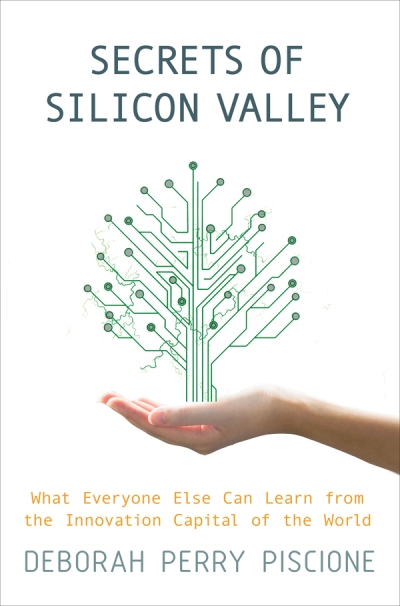 While the global economy languishes, one place just keeps growing despite failing banks, uncertain markets, and high unemployment: Silicon Valley. In the last two years, more than 100 incubators have popped up there, and the number of angel investors has skyrocketed. In Secrets of Silicon Valley, entrepreneur and media commentator Deborah Perry Piscione aims to take readers inside this vibrant ecosystem, exploring Silicon Valley’s exceptionally risk-tolerant culture, and why it thrives despite the many laws that make California one of the worst states in the union for business. Reviewed by Merlin Linehan.
While the global economy languishes, one place just keeps growing despite failing banks, uncertain markets, and high unemployment: Silicon Valley. In the last two years, more than 100 incubators have popped up there, and the number of angel investors has skyrocketed. In Secrets of Silicon Valley, entrepreneur and media commentator Deborah Perry Piscione aims to take readers inside this vibrant ecosystem, exploring Silicon Valley’s exceptionally risk-tolerant culture, and why it thrives despite the many laws that make California one of the worst states in the union for business. Reviewed by Merlin Linehan.

Secrets of Silicon Valley: What Everyone Else Can Learn from the Innovation Capital of the World. Deborah Perry Piscione. Palgrave Macmillan. April 2013.
A book which explains the secrets behind the world’s technology Mecca should be valuable to the many imitators of Silicon Valley which have sprung up in Ontario, New York, Beijing, and Tel Aviv, and are on the drawing boards of many other town halls around the world. The promise that the power of technological innovation can transform economies has long captured the minds of economists and policy makers. In the present day, advancements in mobile technology have transformed the way in which we communicate with each other. The rise of social media holds the promise that crowdsourcing can help solve our social issues and that developments in solar and wind power can answer our energy and climate challenges.
This book is part guide, part history and part love letter to Silicon Valley, rather than a practical guide to implementing its secrets globally, and is written with a passion that perhaps can only come from a convert. Deborah Piscione arrived from Capitol Hill and its world of lobbyists and legislators, a place which is of course famed for its breath-taking cynicism and back stabbing. Piscione paints Washington in stark contrast to her new home, Silicon Valley, which is a land of milk and honey in comparison, where as she writes people: “talk to one another, and even look out for each other”(p.5). After describing her own background and experiences the author goes onto describe a different aspect of Silicon Valley in each chapter, such as the University (Stanford), how companies are financed, and the history of the region. Of most interest, however, were the descriptions of entrepreneurs and the innovation cycle.
While my inner cynic bridled at suggestions that social media allows “individuals [to] develop a social graph that can be leveraged to create more overall well-being than ever before” with little consideration given to the negative impact of social media (p.21), my more optimistic side was thrilled by the descriptions of far-sighted entrepreneurs who love nothing better than setting up innovative, world changing software companies before going on to do the same trick in other sectors. Covered in the book are those such as the inspirational Elon Musk, a South African born serial entrepreneur who founded PayPal before moving onto electric car manufacturer Tesla Motors, and then to complete the hat-trick working at SolarCity, a successful Californian renewable energy company. Another inspirational story was that of Christina Brodbeck who horrified her family by quitting her job with $40,000 worth of student loans to work for nothing on a Silicon Valley start-up. Fortunately that start-up was YouTube, and in retrospect it was a risk well worth taking.
At times the book is a breathless run through of new ideas and futurology, which is easy to get excited about, but at the same time it is easy to recall how many other predictions for the future fail to materialise. Will we really witness “singularity” – the optimistic idea that technological progression will allow humans to overcome their biological limitations – increase our creative potential and solve problems such as hunger, pollution and poverty?
The one word which crops up over and over again is innovation. Piscione explains how innovation differs from improvement, as it is doing something differently rather than the same thing better. Innovative companies are constantly improving, testing, experimenting and the same goes for individuals who are defined by their “creative intelligence”. The downside of this of course is failure. Failing is perhaps the most under appreciated art of all, yet vital in entrepreneurship and innovation, as most experiments do not initially work, or at least not in the way they were originally conceived. The Valley has a high tolerance of failure, which helps people to bounce back from bankruptcy and to access funding despite disappointments in the past. This tolerance allows entrepreneurs who have failed to start afresh, facing little stigma in comparison to other sectors. It would have been useful to read more on how individuals made decisions that went on to create innovative products. Although subjects such as the discussion of patent law, lawyers, and the battles they fight are important, the book could have done more to illuminate the creative process that spurs on innovation.
While the book’s strengths lie in its descriptions of companies and their bold, imaginative technological innovations which have transformed the world, it is debatable as to whether the key lessons can be adopted by other industries, as the book suggests in its title. As we have seen, innovation in banking is not always desirable and some may doubt whether the creative, non-hierarchical, collaborative structures utilised by many tech companies would work in other fields. Also, more details about when things go wrong would have been useful; a relentlessly upbeat book is great on first reading, but businesses do fail, recessions happen, and disaster is just as interesting and educational as learning about success.
If I was moving to Silicon Valley, this book would be a fantastic guide, I would have a great idea of the dynamics of the area, the best places to raise capital, where to hang out and eat, and even the benefits of raising children and living in that rarefied environment. As a cheerleader for Silicon Valley’s business leaders, entrepreneurs and institutions, Piscione excels, throwing the spotlight on its genuinely brilliant people and ideas. If I was in the business of trying to learn from Silicon Valley there is a lot I could take away, but it is an unrealistic expectation to apply the Silicon Valley formula to other sectors. The book would be a useful read for anyone studying business, or for an MBA, but is accessible to anyone interested in this fascinating place.
—————————–
Merlin Linehan is currently writing a book on trade and investment between rising powers and previously worked as a financial analyst and consultant in the fields of SMEs, clean energy and donor finance for the European Bank for Reconstruction and Development. Merlin holds an MSc in Finance and Financial Law from SOAS. Merlin blogs on South –South trade at thekularingtradeblog.com and tweets @MerlinLinehan. Read more reviews by Merlin.








trying to learn more from silicon valley.